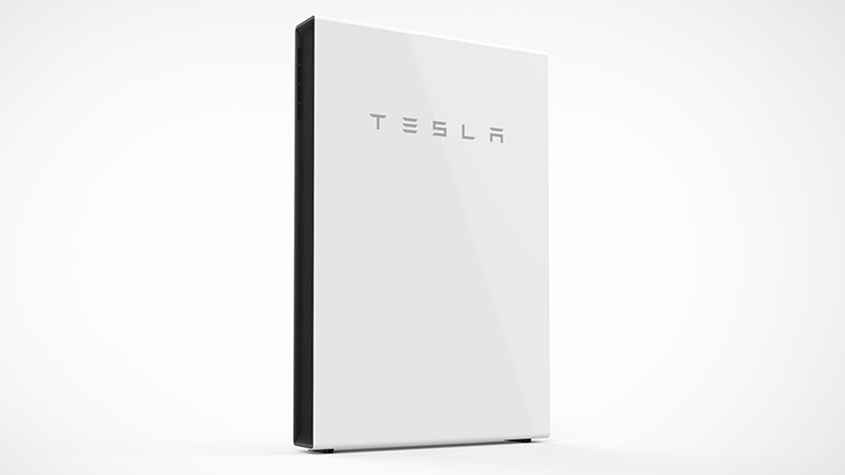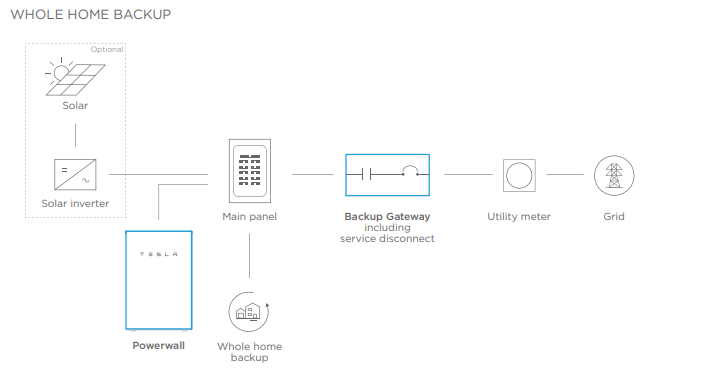See how much solar panels cost in your area

Please enter a valid zip code.
Zero Upfront Cost
Best Price Guaranteed
![]()
![]()
Solar Learning Center > Solar Battery > Tesla Powerwall
Tesla Powerwall

With energy prices soaring and extreme weather knocking out power more frequently, more homeowners than ever can benefit from pairing solar with battery.
The Tesla Powerwall and Powerwall+ are two must-consider options when it comes to battery storage. In this article, we’ll breakdown the specifications, advantages, and costs of the Tesla Powerwall.
See how much you can save with a Tesla Powerwall.
Tesla Powerwall Basics
The Tesla Powerwall is the best-known home battery on the market. The Powerwall sets the standard for the solar battery industry — it offers a great balance of capability, capacity, flexibility, and software, all at a very compelling price point.
Tesla manufactures the Powerwall at its giant battery factory, nicknamed the “Gigafactory,” outside Reno, Nevada. While this facility also produces battery packs for vehicles, Tesla uses a slightly different chemistry in the Powerwall to optimize its functionality as a stationary storage system.
The Tesla Powerwall provides all the standard advantages of solar batteries, including backup protection against grid outages, time-of-use load-shifting, and greater energy independence.
The Powerwall also comes with industry-leading software that allows homeowners to view the power flows in their home and adjust battery settings on the fly.

Tesla Powerwall version history
There are currently three versions of the Tesla Powerwall in existence, with a fourth apparently in the works for Spring 2023.
The first version of the Powerwall was a DC battery that launched in 2015. This version has since been discontinued.
This was followed closely by the Powerwall 2 in 2016, an AC battery with more than doubled the capacity of the original version.
Early Powerwall models and competitors, such as Sonnen and LG, are DC batteries, which require a separate inverter to convert electricity to AC before it sending it to the home or grid.
For the Powerwall 2, this inverter is part of the package, streamlining the configuration by eliminating the need for the separate inverter. However, the Powerwall 2 still required a separate solar inverter in order to receive and store solar output.
The latest version is the Powerwall+. The Powerwall+ is essentially the Powerwall 2 with the addition of a built-in solar inverter. This allows the Powerwall+ to directly receive DC electricity from solar panels and eliminates the need for yet another series of solar inverters.
Powerwall 2 configuration

Powerwall+ configuration

Finally, the Powerwall 3 was set to be released in Spring 2022, but is likely delayed until at least Spring 2023. It’s expected to have double the capacity of the Powerwall 2, among other optimizations.
Tesla Powerwall Specs
| Category | Powerwall 2 | Powerwall+ |
| Capacity (usable) | 13.5 kWh | 13.5 kWh |
| AC/DC | AC | AC |
| Max Output | 5 kW continuous / 7 kW peak | 5,8 kW continuous / 7.6 kW peak |
| Max amps of backup circuits | 30 amps | 50 amps |
| Dimensions | 45.3”H x 29.6”W x 5.8”D | 62.8″H x 29.7″W x 6.3″D |
| Stackable output? | Yes | Yes |
| TOU load-shifting? | Yes | Yes |
| Warranty | 10 Years / 70% Capacity Retention | 10 Years / 70% Capacity Retention |
| Spec Sheet | Tesla Powerwall 2 Spec Sheet | Tesla Powerwall+ Spec Sheet |
| Battery only cost (before incentives) | $7,500 | $8,500 |
Tesla Powerwall Advantages
One of the biggest advantages of Powerwall is stackable output. Because Powerwall is an AC battery, its output is stackable, meaning that adding more batteries will provide greater amounts of power.
So while one Powerwall outputs 5kW, two Powerwalls will output 10kW, three will output 15kW, etc. This also increases the amperage of the circuits that can be backed up. While one Powerwall can back up circuits up to 30 amps, two Powerwalls can back up circuits up to 60 amps, three up to 90 amps, etc.
This compares favorably to DC batteries, which do not have stackable output.
Installing multiple DC batteries will increase the system’s storage capacity – meaning the system will provide power for a longer duration in an outage – but the overall system output doesn’t increase. Multiple DC batteries can only back up the same circuit amperage that one battery can.
Another big advantage of Powerwall is its thermal management system. Powerwall, like Tesla vehicles, has a liquid heating and cooling system running through the battery pack that keeps the cells operating at the ideal temperature.
This system improves long-term performance, reduces degradation, and makes Powerwall more resilient for outdoor installations in high-heat areas.
Tesla Powerwall Cost
When purchased directly from Tesla, the Powerwall+ comes to $11,500 with installation included.
But there’s a kicker: Tesla no longer sells the Powerwall individually. In order to get the $11,5oo all-in price, you’d have to buy solar from Tesla, too.
Going directly through Tesla is a great way to get bulk pricing on solar and storage, but if you want a Powerwall on its own, you’ll need to go through a local installer.
Buying a Tesla Powerwall through a local installer typically runs about $12,000-$16,500 fully installed ($8,400 to $11,550 after the 30% federal tax credit is applied). That includes all of the ancillary components needed to make the battery function – see our article on solar battery pricing for more information about the factors that contribute to battery pricing.
If homeowners buy multiple batteries at the same time, installers will typically reduce the cost of the subsequent batteries, since some of the equipment can be economized.
Get multiple quotes from local installers. Start here.
Does the Tesla Powerwall qualify for the 30% federal tax credit?
Yes! With the passage of the Inflation Reduction Act, all battery with capacity greater than 3 kWh qualifies for the 30% Residential Clean Energy Credit.
This new and improved credit now applies to standalone battery (battery storage not paired with solar) and battery storage added to existing solar systems.
There are also state and local incentives like California’s SGIP program that offers rebates up to $1,000 per kWh of battery storage installed.
The Bottom Line
Overall, Powerwall is an industry-leading option home battery. It offers great capabilities at a very compelling price point.
The Powerwall can store solar or grid energy to use during power outages or to work around expensive time-of-use rates. When paired with solar, battery storage turns your home into a mini-utility powered by clean energy.
Boris Feldman is our own Solar.com customer who had a Tesla Powerwall 2 installed at home. Here’s what he had to say about his experience with his new backup battery.
“The Powerwall 2 is a really cool piece of technology that allows me to have total control of our household electrical usage. It’s a sleek design, and the mobile app is incredibly intuitive.”
Related Articles
SCE Approves the Tesla Backup Switch Paving Way for Lower Powerwall Pricing
Home battery storage is crucial for backup power and maximum solar savings in California — and it just got faster and more cost-effective to install....
Why the Tesla Backup Switch is a Game-Changer for Home Backup Power
Tesla has a knack for bringing emerging technologies into the mainstream. The Model Y did it for electric vehicles and the Powerwall did it for...
Tesla Powerwall 2 - 2018 Buyers Update
Tesla’s Powerwall 2 is perhaps the most famous solar backup battery option, though it is not the highest volume sold. Tied to celebrity tech entrepreneur...
Tesla Powerwall 2 vs. Sonnen Eco
On October 28th, Elon Musk dazzled audiences with the unveiling of Tesla’s Solar Roof and updated Powerwall home energy storage system. Fans are already putting...
See how much solar panels cost in your area.

Please enter a valid zip code.

Please enter a valid zip code.
Zero Upfront Cost. Best Price Guaranteed.





